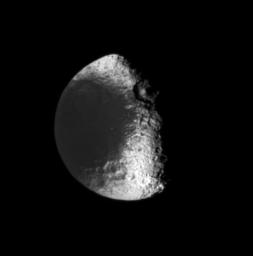
|
To the Relief of Iapetus
- Click the image above for a larger view
- Full-Res JPEG (638 x 646) (14.3 kB)
- Full-Res TIFF (638 x 646) (412.8 kB)
Caption:
Sunlight strikes the terminator (the boundary between day and night) region on Saturn's moon Iapetus at nearly horizontal angles, making visible the vertical relief of many features.
This view is centered on terrain in the southern hemisphere of Iapetus (1,468 kilometers, or 912 miles across). Lit terrain visible here is on the moon's leading hemisphere. In this image, a large, central-peaked crater is notable at the boundary between the dark material in Cassini Regio and the brighter material on the trailing hemisphere.
The image was taken in visible light with the Cassini spacecraft narrow-angle camera on Jan. 22, 2006, at a distance of approximately 1.3 million kilometers (800,000 miles) from Iapetus and at a Sun-Iapetus-spacecraft, or phase, angle of 67 degrees. Resolution in the original image was 8 kilometers (5 miles) per pixel. The image has been magnified by a factor of two and contrast-enhanced to aid visibility.
Background Info:
The Cassini-Huygens mission is a cooperative project of NASA, the European Space Agency and the Italian Space Agency. The Jet Propulsion Laboratory, a division of the California Institute of Technology in Pasadena, manages the mission for NASA's Science Mission Directorate, Washington, D.C. The Cassini orbiter and its two onboard cameras were designed, developed and assembled at JPL. The imaging operations center is based at the Space Science Institute in Boulder, Colo.
For more information about the Cassini-Huygens mission visit http://saturn.jpl.nasa.gov/home/index.cfm . The Cassini imaging team homepage is at http://ciclops.org .
Cataloging Keywords:
| Name | Value | Additional Values |
|---|---|---|
| Target | Iapetus | |
| System | Saturn | |
| Target Type | Satellite | |
| Mission | Cassini-Huygens | |
| Instrument Host | Cassini Orbiter | |
| Host Type | Orbiter | |
| Instrument | Imaging Science Subsystem (ISS) | |
| Detector | Narrow Angle Camera | |
| Extra Keywords | Crater, Grayscale, Visual | |
| Acquisition Date | ||
| Release Date | 2006-03-02 | |
| Date in Caption | 2006-01-22 | |
| Image Credit | NASA/JPL/Space Science Institute | |
| Source | photojournal.jpl.nasa.gov/catalog/PIA08125 | |
| Identifier | PIA08125 | |
